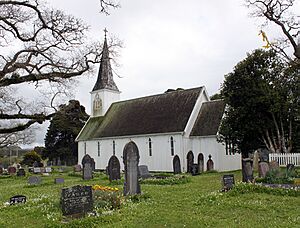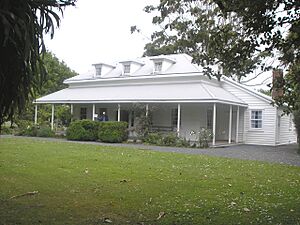Te Waimate Mission facts for kids
Te Waimate Mission was an important early settlement in New Zealand. It was the fourth mission station set up by the Church Missionary Society (CMS) and the very first one built away from the coast, inland from the Bay of Islands. The main people who started Te Waimate Mission at Waimate North were Reverend William Yate and other members like Richard Davis, George Clarke, and James Hamlin.
Contents
Starting the Te Waimate Mission
The idea for Te Waimate Mission came from Samuel Marsden. The CMS wanted to create a special farming village for Māori people there. They bought the land from the Ngāpuhi tribe after a conflict called the Girls' War in 1830.
In 1830, Richard Davis, who was a farmer and a CMS member, started a farm at the Waimate Mission.
In 1835, William Williams, his wife Jane, and their family moved to Waimate. William Williams continued his important work of translating the Bible into Māori. A boarding school for the sons of CMS missionaries also moved from Paihia to Te Waimate Mission. Richard Taylor took over as the head of the Waimate Boys’ School in September 1839.
A famous visitor, Charles Darwin, came to Te Waimate Mission on December 23 and 24, 1835. This was when his ship, HMS Beagle, spent ten days in the Bay of Islands.
The mission village had three wooden houses for the missionary families. It also had a flour mill, a printing shop, a carpenters' shop, a brickworks, a blacksmith, and a school. Of course, there was also a church. Marsden hoped that Māori people would learn European ways and that the mission would make money. They planned to sell goods to European ships and to local Māori through the Stone Store at Kerikeri. However, this plan to teach European culture and use Māori as workers didn't attract many people. So, the mission station slowly became less active.
St. John the Baptist Church

Building St. John the Baptist Church began in May 1831 and was finished very quickly, in just six weeks. The church was named St. John the Baptist because his day is on June 24. The first church building was also used as a schoolroom.
The first child to be baptised at the church was Edward Blomfield Clarke on July 10, 1831. The first wedding between two Europeans in New Zealand happened here on October 11, 1831. It was between William Gilbert Puckey (26), whose father was a CMS carpenter, and Matilda Elizabeth Davis (17), who was the second daughter of Reverend Richard Davis.
The church building you see today, St. John the Baptist Church, was built later in 1871.
St. John’s College at Te Waimate Mission
In June 1842, Bishop George Selwyn moved to Te Waimate Mission. Some of the mission buildings were changed to be used by St. John’s College. This college taught theology to people who wanted to become Anglican priests. Some of the people who became deacons (a type of church leader) there were:
- Richard Davis (June 11, 1843)
- Seymour Mills Spencer, William Bollard, and Henry Francis Butt (September 24, 1843)
- William Colenso, Thomas Chapman, James Hamlin, Joseph Matthews, and Christopher Pearson Davies (September 22, 1844)
On September 26, 1844, Bishop Selwyn led the very first Synod (a church meeting) held in New Zealand. Later in 1844, Bishop Selwyn moved his home and St. John’s College to Auckland.
Te Waimate Mission After 1845
During the Flagstaff War, soldiers from the 58th and 99th Regiments who were injured or died in the Battle of Ohaeawai (July 1845) were buried in the graveyard of St. John the Baptist Church. This included Captain Grant and Lieutenant George Phillpotts from HMS Hazard. The mission station was used as the main base for the British army from June 15, 1845, to October 6, 1845. After this, the mission lost support from many Māori people.
The mission station slowly fell apart, and its buildings were later put up for sale.
Today, the only original building left on the site is the house where George Clarke lived. It is now looked after by Heritage New Zealand and is a museum. One of the other original houses is still around at the Butler Point Whaling Museum. A third building was sold and moved to Kerikeri, where it is still used as a home on Springbank Lane.
CMS Members at Te Waimate Mission
Many members of the Church Missionary Society worked at Te Waimate Mission, including:
- William Yate: He arrived in the Bay of Islands in 1828 and was chosen to lead Te Waimate Mission in 1830. He left the CMS in 1834.
- George Clarke: He arrived in 1824 and first worked as a blacksmith in Kerikeri. He then worked at Te Waimate Mission from 1830 to 1840, teaching Māori students.
- Richard Davis: A farmer, he arrived in 1824. In 1830, he started a farm at the Waimate Mission and stayed there until 1845. He became a priest in 1843. He worked in Kaikohe from 1845 to 1854, then returned to Te Waimate Mission from 1854 to 1863.
- William Gilbert Puckey: He worked at Te Waimate Mission before starting the Kaitaia Mission in 1834. He was very good at the Māori language, which helped him translate the New Testament with William Williams in 1837 and revise it in 1844.
- James Hamlin: He arrived in 1826 and worked as a catechist (a religious teacher) at Te Waimate Mission from 1830 to 1834. In 1834, he left to start a mission station at Puriri.
- William Williams: He moved to Te Waimate Mission in 1835 and became the head of the Waimate Boys’ School. He continued his work on translating the Bible into Māori. In 1839, he and his family left Waimate to start the Poverty Bay Mission at Tūranga.
- Richard Taylor: He arrived in 1839 and became the head of the school at Te Waimate Mission that same year, staying until 1842. In 1842, he moved to the mission station at Whanganui.
- William Colenso: He arrived in 1834 to work as a printer at Paihia. In 1843, he went to Te Waimate Mission to study to become a priest. He became a deacon in 1844 and was sent to open a new mission station at Ahuriri, in Napier.
- Robert Maunsell: He arrived at Te Waimate Mission in 1835 and was sent to start the Manukau mission station that same year. Maunsell became a top expert in the Māori language. After 1844, he worked with William Williams to revise the Bible translation. He revised the Old Testament translation into the Māori language, with parts published in 1840 and the full translation finished in 1857.
- Robert Burrows: He was appointed to St. John the Baptist Church in 1844 and stayed at Te Waimate Mission until 1854.
- Henry Williams: He was the Archdeacon (a senior church leader) of Te Waimate from 1844 to 1867.
- Edward Blomfield Clarke: The son of George Clarke, he was appointed to St. John the Baptist Church (1863–1884) and later became the Archdeacon of Te Waimate (1870–1901).



